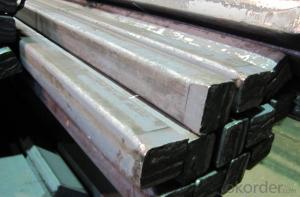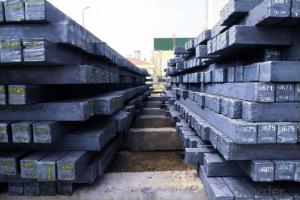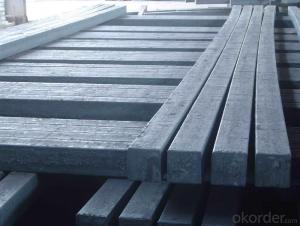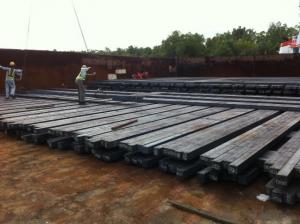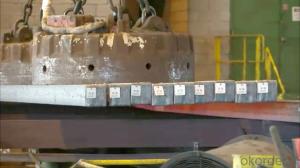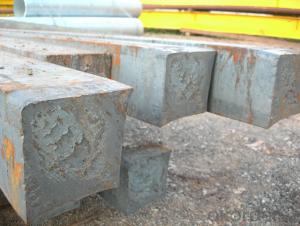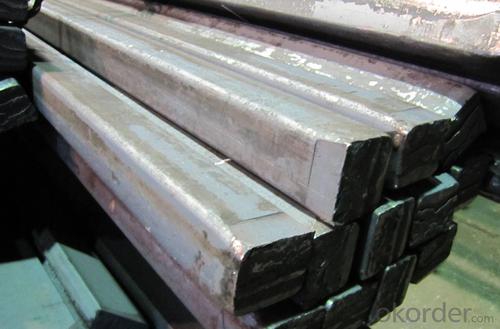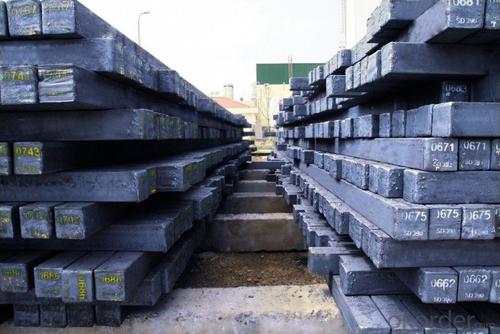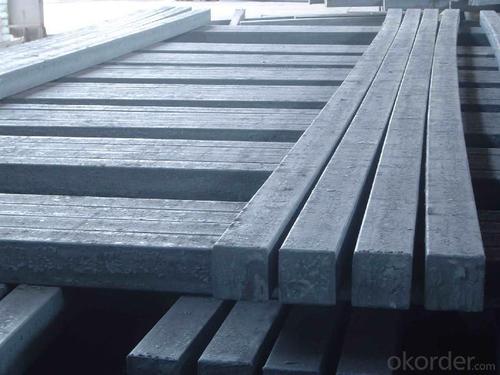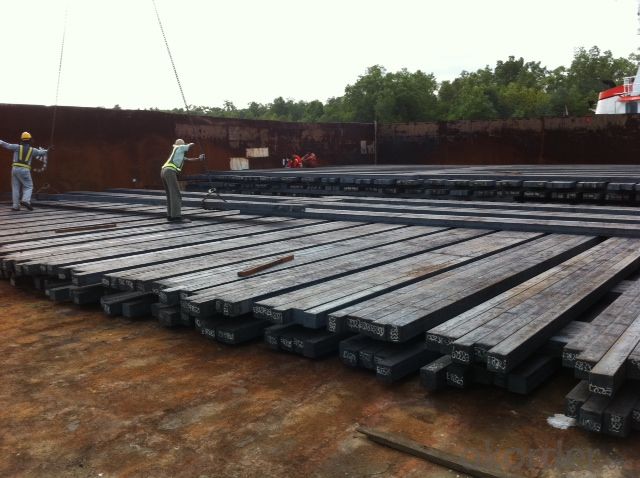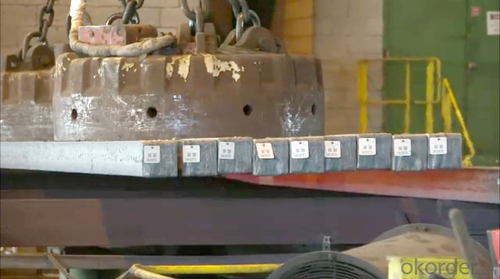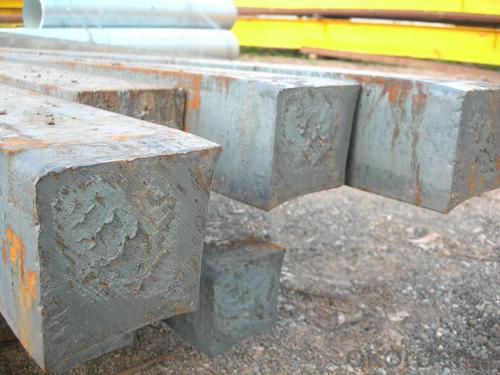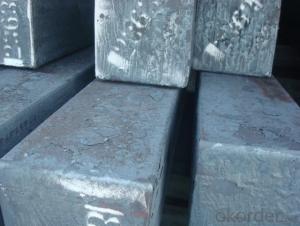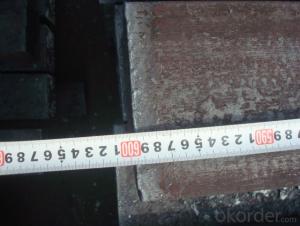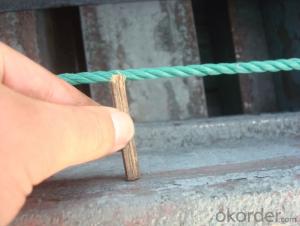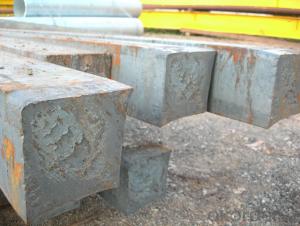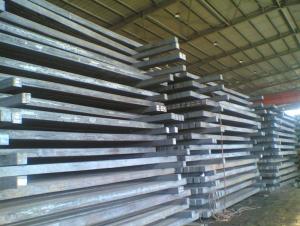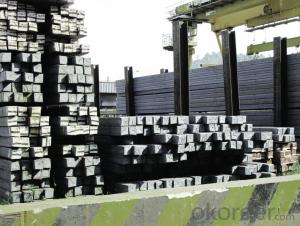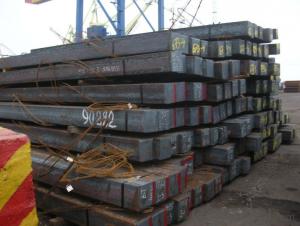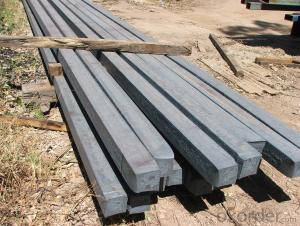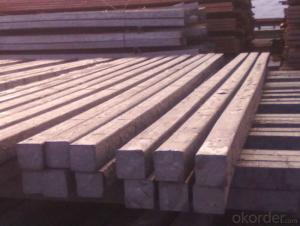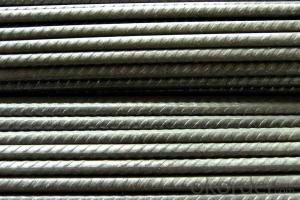Hot Rolled Steel Billet 3SP Standard 180mm
- Loading Port:
- Shanghai
- Payment Terms:
- TT OR LC
- Min Order Qty:
- 100 m.t.
- Supply Capability:
- 10000 m.t./month
OKorder Service Pledge
OKorder Financial Service
You Might Also Like
Structure of Hot Rolled Steel Billet 3SP Standard 180mm
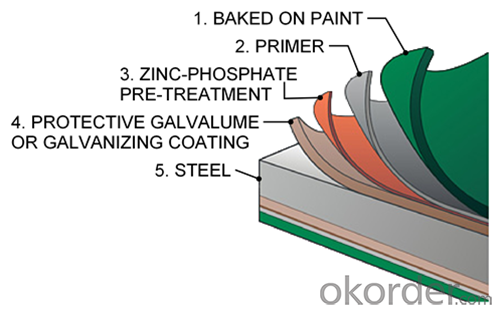
Description of Hot Rolled Steel Billet 3SP Standard 180mm
Prepainted Rolled steel Coil is a kind of coated steel coil/sheet. With the cold rolled steel of different strength and thickness as substrate, it is produced through applying Al-Zn coat on both faces by hot dip process. In its coating, Al accounts for about 55%, Si 1.6%, while the remaining is Zn. Aluminum zinc coils enjoys both the physical protective feature and durability of Al and the electrochemical protective property of Zn. And its surface has bright silver color and regular embossed-like figure, which are highly decorative. RAL Scale Z35 Prepainted Rolled Steel Coil for Construction Roofing
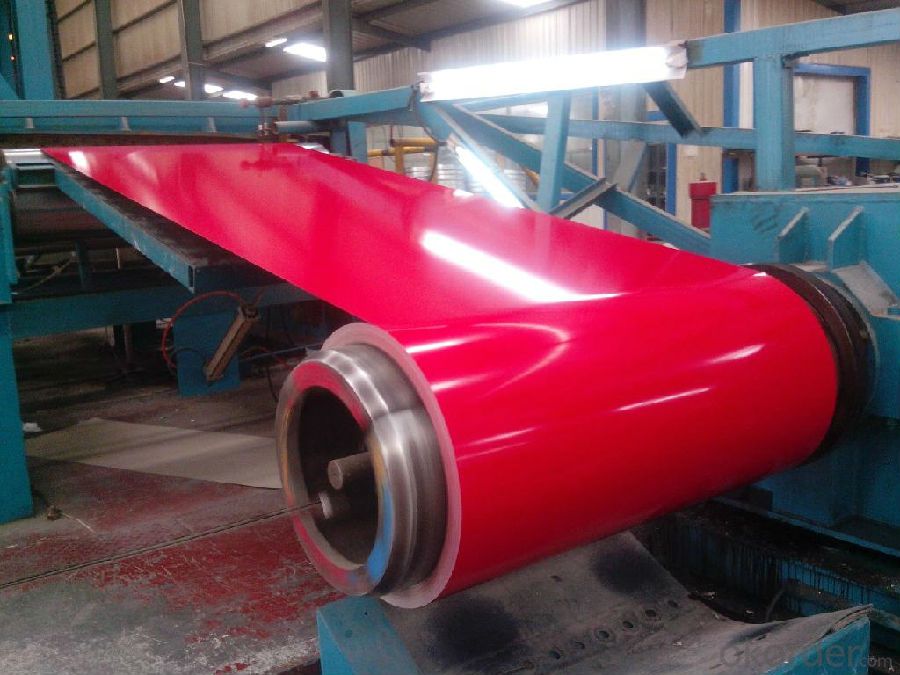
Main Feature of Hot Rolled Steel Billet 3SP Standard 180mm
1.Corrosion resistance: It mainly depends on the zinc protection. When the zinc being worn,
2. Heat resistance: steel sheet has excellent heat resistance, can withstand high temperatures over 300 centigrade, and is similar with aluminized steel high temperature oxidation resistance. It often used in chimney pipes, ovens, fluorescent lighting device and the device cover.
3. Heat reflective: Galvanized steel plate heat-reflective high rate is twice as galvanized steel, often used to make insulation materials. RAL Scale Z35 Prepainted Rolled Steel Coil for Construction Roofing
Applications of Hot Rolled Steel Billet 3SP Standard 180mm
1. Construction and building: roofing; ventilating duct; handrail; partition panel;etc.
2. Electric appliance: refrigerator; washing machine; refrigerator; DVD;etc.
3.Transportation: oil tank; gas tank;road sign; etc.
4.Agriculture constructions :barn; etc.RAL Scale Z35 Prepainted Rolled Steel Coil for Construction Roofing
5.Others:vending machine; game machine; auto parts spare parts etc.
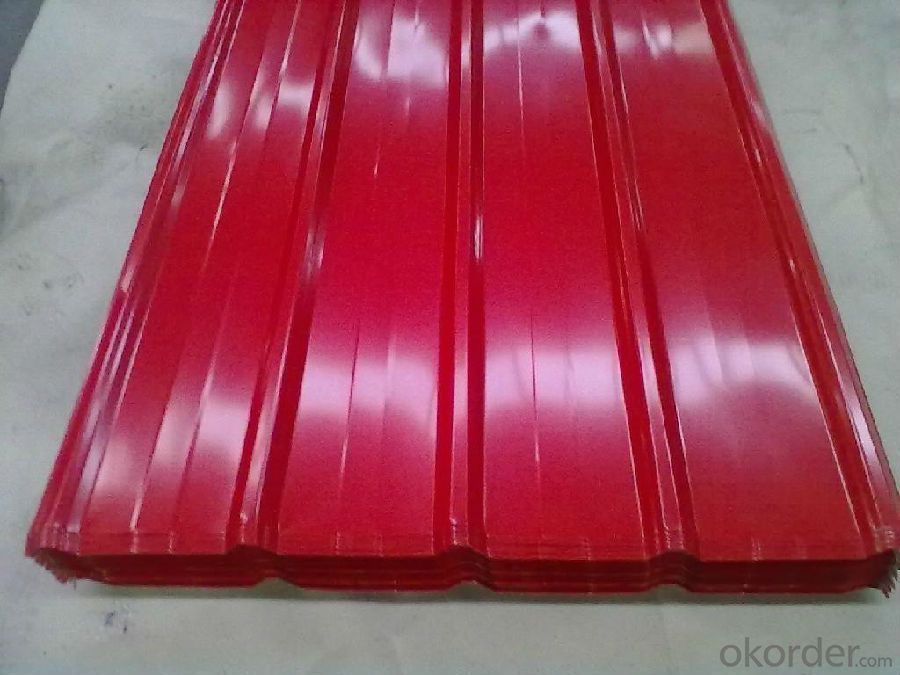
Specifications of Hot Rolled Steel Billet 3SP Standard 180mm
Product | Hot Rolled Steel Billet 3SP Standard 115mm |
Material Grade | SGCC / SGCH / DX51D+AZ, etc |
Thickness | 0.5-3.0mm |
Width | 700-1500mm |
Tolerance | Thickness: +/-0.02mm , Width:+/-2mm |
Zinc-coating | AZ30-150g/m2 |
Technique | Raw material: Hot rolled steel coil --> Cold rolled_>hot dipped galvalume |
Surface | Dried, Chromated, Unoiled,RAL Scale Z35 Prepainted Rolled Steel Coil for Construction Roofing |
Spangle | Regular spangle , small spangle, zero spangle |
ID | 508MM 610MM |
Coil weight | 25MT max |
Export package | Cardboard inner sleeves, Waterproof paper, galvanized steel covered and steel strip packed |
FAQ of Hot Rolled Steel Billet 3SP Standard 180mm
We have organized several common questions for our clients,may help you sincerely:
1. What is the minimum order quantity ?
Our MOQ is 100 mt for each size each specification. Usually we can offer discount if can buy large QTY once. RAL Scale Z35 Prepainted Rolled Steel Coil for Construction Roofing
2. How long can we receive the product after ordering?
Our general delivery time is 30 days after confirmation, but so some special orders, we have offer special delivery time
3. How to guarantee the quality of the products?
We have established the international advanced quality management system ,every link from raw material to final product we have strict quality test;We resolutely put an end to unqualified products flowing into the market. At the same time, we will provide necessary follow-up service assurance.
4. What is the payment?
We accept T/T, L/C
- Q: How are steel billets used in the manufacturing of pipeline fittings?
- Steel billets are used in the manufacturing of pipeline fittings by being heated and shaped into the desired form. They serve as the raw material that is then further processed and machined to create various types of fittings such as elbows, tees, reducers, and flanges. The steel billets undergo a series of forging, cutting, and welding processes to achieve the required dimensions and specifications for the pipeline fittings.
- Q: What are the different surface treatments for improved surface roughness in steel billets?
- To enhance the surface roughness of steel billets, there are various surface treatments available. These treatments aim to improve the quality and properties of the billets, making them more suitable for different industrial applications. Some commonly used surface treatments for achieving better surface roughness in steel billets are as follows: 1. Shot Blasting: In shot blasting, high-speed abrasive particles are used to bombard the surface of the steel billets. This treatment effectively removes any contaminants, scale, or unevenness present on the surface, resulting in a smoother and more uniform finish. 2. Acid Pickling: Acid pickling involves immersing the steel billets in an acid solution, typically hydrochloric or sulfuric acid. This chemical treatment dissolves any oxides, rust, or scale present on the surface, leaving behind a clean and smoother surface. 3. Mechanical Grinding: Mechanical grinding employs abrasive wheels or belts to remove material from the surface of the steel billets. This treatment is particularly effective in eliminating deep scratches, pits, or irregularities, resulting in a smoother and more polished surface. 4. Electrochemical Polishing: Electrochemical polishing is an electrochemical process that combines chemicals and electrical current to remove a thin layer of material from the steel billet's surface. This treatment helps eliminate any surface imperfections, resulting in a smoother and more reflective finish. 5. Roller Leveling: Roller leveling involves passing the steel billets through a set of rollers that exert pressure on the surface, flattening and smoothing out any irregularities. This treatment is especially effective in improving the flatness and surface roughness of the billets. 6. Thermal Treatment: Thermal treatment, such as annealing, can also enhance the surface roughness of steel billets. Annealing involves heating the billets to a specific temperature and slowly cooling them to relieve internal stresses and improve the surface finish. It is crucial to consider the specific requirements of the steel billets and the desired surface roughness when selecting a surface treatment. Each treatment has its advantages and limitations, and factors such as the type of steel, dimensions of the billets, desired surface finish, and cost-effectiveness should be taken into account when choosing the most suitable treatment.
- Q: How are steel billets used in the manufacturing of agricultural machinery parts?
- Steel billets serve as a crucial raw material for the production of agricultural machinery parts. These billets are essentially semi-finished steel products that act as a starting point for various manufacturing processes. To begin with, steel billets are molded into specific shapes using a range of techniques such as casting, rolling, or extrusion. These processes facilitate the transformation of solid billets into desired forms like bars, rods, or sheets, which then serve as the foundational materials for agricultural machinery parts. After the billets have been shaped, they undergo further refinement through machining, cutting, and welding procedures to create precise components for agricultural machinery. For instance, billets can be machined into shafts, gears, or axles that are integral to the functioning of these machinery parts. Furthermore, the robustness and durability of steel billets make them well-suited for use in heavy machinery like tractors, combines, or harvesters. Agricultural machinery parts manufactured from steel billets possess exceptional tensile strength, resistance to wear and tear, and the ability to withstand the demanding conditions encountered in the agricultural sector. Moreover, steel billets can be subjected to heat treatment to enhance their mechanical properties, such as hardness or toughness, thereby making them more resilient and capable of enduring substantial loads and extreme conditions. This makes them an ideal choice for agricultural machinery parts that frequently encounter intense forces during operation. Additionally, steel billets can be utilized in the production of precision components, such as bearings or bushings, which are vital for the smooth and efficient operation of agricultural machinery. The dimensional accuracy and consistency of steel billets ensure that these precision parts fit flawlessly and perform effectively. Overall, steel billets play a pivotal role in the manufacture of agricultural machinery parts. Their versatility, strength, and ability to be shaped and processed make them an indispensable material in the production of components that can withstand the demanding and challenging conditions prevalent in the agricultural industry.
- Q: What are the common applications of stainless steel billets?
- Stainless steel billets are commonly used in various industries such as construction, automotive, aerospace, and manufacturing. They are used to produce a wide range of products including pipes, tubes, bars, wires, and structural components. The excellent corrosion resistance, high strength, and durability of stainless steel billets make them suitable for applications where resistance to harsh environments, heat, and pressure is required.
- Q: What is the role of steel billets in the manufacturing of storage tanks?
- Steel billets play a crucial role in the manufacturing of storage tanks. These billets serve as the primary raw material for the construction of the tank's structural framework. They are essentially semi-finished steel products that are cast into a specific shape and size, typically in a rectangular or square form. The primary reason for using steel billets in the manufacturing of storage tanks is their exceptional strength and durability. Steel is renowned for its high tensile strength, which allows the tank to withstand the immense pressure and weight of the stored contents. Additionally, steel is resistant to corrosion, making it an ideal material for storage tanks that may hold various liquids or gases. Steel billets are also preferred for their malleability and versatility. They can be easily molded and welded into the desired shape, allowing for the customization of storage tanks to meet specific requirements. The flexibility of steel billets enables the construction of tanks of various sizes and capacities, accommodating different storage needs in industries such as oil and gas, chemical processing, water treatment, and many others. Furthermore, steel billets offer cost-effectiveness in the manufacturing process. The abundance of steel as a raw material and its recyclability contribute to lower production costs, making steel tanks a more economical choice compared to tanks made from other materials. Moreover, the longevity of steel tanks reduces maintenance and replacement costs over time, ensuring a higher return on investment for industries relying on storage tanks. In conclusion, steel billets play a vital role in the manufacturing of storage tanks due to their strength, durability, corrosion resistance, malleability, and cost-effectiveness. These billets form the core framework of the tanks, providing the necessary structural integrity to safely contain and store various liquids or gases. By utilizing steel billets, industries can rely on robust and reliable storage solutions that meet their specific storage requirements.
- Q: What are the common grades of steel used for billets?
- The grades of steel commonly used for billets can vary depending on the intended application and specific requirements. However, there are several widely used grades: 1. Carbon Steel: Carbon steel billets are popular due to their affordability, high strength, and durability. Grades like AISI 1018, 1020, 1045, and 1060 are commonly chosen for general-purpose uses. 2. Alloy Steel: Alloy steel billets are blended with specific alloying elements to enhance their mechanical properties, such as strength, toughness, and corrosion resistance. AISI 4140, 4340, and 8620 are frequently utilized for applications that require increased strength, heat resistance, or wear resistance. 3. Stainless Steel: Stainless steel billets are selected for their excellent corrosion resistance and attractive appearance. Grades such as 304, 316, and 420 are commonly employed in various industries, including construction, automotive, and food processing. 4. Tool Steel: Tool steel billets are specially designed to possess high hardness, wear resistance, and toughness. Grades like AISI O1, D2, and A2 are commonly used in the production of cutting tools, dies, and molds. It is important to note that choosing the appropriate grade of steel depends on specific application requirements, such as mechanical properties, corrosion resistance, and temperature resistance. Seeking advice from a metallurgist or an industry expert can assist in determining the most suitable grade of steel for billet production.
- Q: What are the different types of steel billet heat treatment processes?
- There are several types of steel billet heat treatment processes, including annealing, normalizing, quenching, and tempering. Annealing involves heating the billet to a high temperature and then slowly cooling it to relieve internal stresses and improve its ductility. Normalizing is similar to annealing but involves cooling the billet in still air to achieve a more uniform grain structure. Quenching is a rapid cooling process that involves immersing the billet in a quenching medium, such as water or oil, to achieve high hardness and strength. Tempering follows quenching and involves reheating the billet to a lower temperature to reduce brittleness and enhance toughness.
- Q: How are steel billets inspected for surface cleanliness?
- Steel billets are inspected for surface cleanliness through a series of visual and nondestructive testing methods. One of the commonly used techniques is visual inspection, where trained inspectors visually examine the surface of the billets for any visible impurities, such as scale, rust, dirt, or any other contaminants. This method helps identify any surface irregularities that may affect the quality of the billets. Additionally, nondestructive testing methods like magnetic particle inspection (MPI) and ultrasonic testing (UT) are employed to further evaluate the surface cleanliness of steel billets. Magnetic particle inspection involves applying a magnetic field to the billet's surface and then applying iron particles to it. If any surface cracks or defects are present, the iron particles will be attracted to these areas, making them visible to the inspector. Ultrasonic testing, on the other hand, uses high-frequency sound waves to detect any internal or surface defects. A probe is placed on the billet's surface, and sound waves are transmitted into the material. These waves are then reflected back to the probe and analyzed to identify any defects, such as inclusions or voids, which may affect the surface cleanliness. Overall, a combination of visual inspection, magnetic particle inspection, and ultrasonic testing is used to ensure that steel billets meet the required surface cleanliness standards. These inspection methods help identify any impurities or defects that could potentially compromise the quality and performance of the final steel product.
- Q: Difference between billet, slab and billet
- Steel billet is a product made by steel-making furnace by casting. The billet can be divided into two kinds from the manufacturing process, mould blank and continuous casting billet. At present, the casting process has been basically eliminated. The classification is mainly divided into two kinds: slab: large cross section, high ratio, mainly used for rolling plate. Billet: cross section width, height equal, or difference is not big, mainly used for rolling steel, wire. Use billet is steel, through processing can be used as mechanical parts, forgings, processing all kinds of steel, steel, Q345B, channel steel, wire is the role of billet. Billet is used for the production of semi-finished steel products, generally can not be used directly for society. Billet and steel are strictly divided into standard, and can not be determined by the final product of the enterprise, but should be carried out according to the uniform standard of the whole society. Usually, billet and steel is relatively easy to distinguish, but for some billets, with the same specification and the same purpose (such as rolling and steel tube), whether for other industries by use, whether through steel processing process, whether after finishing mill processing to distinguish. Continuous cast steel square and rectangular billets are mainly made of plain carbon steel, low carbon and low silicon cold rolled material, high quality carbon structural steel, low alloy high strength steel, special steel and so on.
- Q: What are the potential applications of steel billets in the transportation aftermarket?
- Steel billets offer a wide range of potential applications within the transportation aftermarket. One primary use in this industry involves using steel billets to produce various components and parts for vehicles. These billets possess the strength and durability necessary for manufacturing engine parts, suspension components, steering parts, and other critical components. Moreover, steel billets are well-suited for manufacturing structural components like chassis frames and body panels. The robustness and rigidity of steel make it an ideal material for these applications, allowing it to withstand the stresses and strains experienced during vehicle operation. Additionally, steel billets find use in producing wheels and rims for automobiles, motorcycles, and bicycles. Their exceptional strength and ability to handle heavy loads make steel billets the preferred choice for wheel manufacturing, ensuring road safety and reliability. Furthermore, steel billets can be utilized in manufacturing rail tracks and infrastructure for railways. The strength and durability of steel make it an ideal material for rail tracks, ensuring the secure and efficient transportation of goods and passengers. All in all, the applications of steel billets in the transportation aftermarket are diverse and extensive. They play a crucial role in manufacturing critical vehicle components and constructing infrastructure for railways, ultimately ensuring the efficiency, safety, and reliability of transportation systems.
Send your message to us
Hot Rolled Steel Billet 3SP Standard 180mm
- Loading Port:
- Shanghai
- Payment Terms:
- TT OR LC
- Min Order Qty:
- 100 m.t.
- Supply Capability:
- 10000 m.t./month
OKorder Service Pledge
OKorder Financial Service
Similar products
Hot products
Hot Searches
Related keywords
